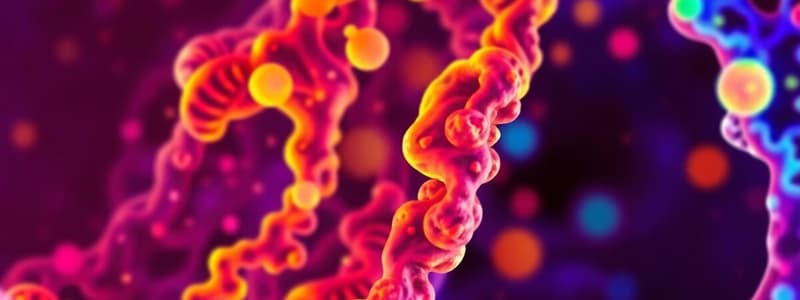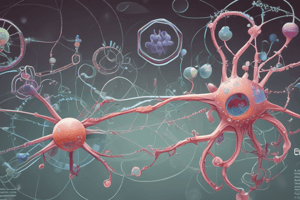Podcast
Questions and Answers
Which of the following best describes the role of enzymes within the function of proteins?
Which of the following best describes the role of enzymes within the function of proteins?
- They act as receptors to which drugs bind to initiate cellular responses.
- They catalyze reactions by breaking down substances like sugars and DNA. (correct)
- They facilitate movement, similar to how muscles function.
- They serve as structural components like collagen in hair and wool.
If a protein's structure is altered due to denaturation, what is the most likely consequence?
If a protein's structure is altered due to denaturation, what is the most likely consequence?
- The protein will be able to perform multiple functions.
- The protein's function will be enhanced due to the structural change.
- The protein will maintain its original function regardless of the structural change.
- The protein will lose its function because its 3D structure is essential for bioactivity. (correct)
Amino acids are the building blocks of proteins and are linked by what type of bond?
Amino acids are the building blocks of proteins and are linked by what type of bond?
- Ester bond
- Ionic bond
- Peptide bond (correct)
- Glycosidic bond
What type of reaction forms a peptide bond between two amino acids?
What type of reaction forms a peptide bond between two amino acids?
Which element is always present in every amino acid?
Which element is always present in every amino acid?
How does hydrolysis break down proteins?
How does hydrolysis break down proteins?
Which of the following is the correct hierarchy of protein structure?
Which of the following is the correct hierarchy of protein structure?
What is the primary factor that distinguishes one amino acid from another?
What is the primary factor that distinguishes one amino acid from another?
What determines the unique primary structure of a protein?
What determines the unique primary structure of a protein?
Which function of proteins is specifically responsible for carrying oxygen in the blood?
Which function of proteins is specifically responsible for carrying oxygen in the blood?
Mutations in a gene can directly alter which level of protein structure?
Mutations in a gene can directly alter which level of protein structure?
What type of bond is directly responsible for the formation of alpha-helices and beta-pleated sheets in protein secondary structure?
What type of bond is directly responsible for the formation of alpha-helices and beta-pleated sheets in protein secondary structure?
A mutation in the gene sequence can cause a change in a protein. What can be the consequence?
A mutation in the gene sequence can cause a change in a protein. What can be the consequence?
Which level of protein structure is primarily determined by interactions between the R groups of amino acids?
Which level of protein structure is primarily determined by interactions between the R groups of amino acids?
What is required for a protein to have a quaternary structure?
What is required for a protein to have a quaternary structure?
What is the role of iron (Fe) in the function of hemoglobin?
What is the role of iron (Fe) in the function of hemoglobin?
During protein digestion, polypeptide chains are broken down into what smaller units?
During protein digestion, polypeptide chains are broken down into what smaller units?
Which of the following is the MOST direct consequence of protein denaturation?
Which of the following is the MOST direct consequence of protein denaturation?
Which environmental factor, when drastically increased, does NOT typically cause protein denaturation?
Which environmental factor, when drastically increased, does NOT typically cause protein denaturation?
Why are freeze-thaw cycles generally avoided when handling proteins?
Why are freeze-thaw cycles generally avoided when handling proteins?
Which analytical technique is used to separate and identify amino acids based on their differential migration on a stationary phase?
Which analytical technique is used to separate and identify amino acids based on their differential migration on a stationary phase?
Spectrophotometry at 280 nm is used to estimate protein concentration based on the absorbance of which amino acids?
Spectrophotometry at 280 nm is used to estimate protein concentration based on the absorbance of which amino acids?
In spectrophotometry, how is the concentration of an unknown protein sample typically determined?
In spectrophotometry, how is the concentration of an unknown protein sample typically determined?
If a protein solution shows very low absorbance at 280 nm using spectrophotometry, what can you infer?
If a protein solution shows very low absorbance at 280 nm using spectrophotometry, what can you infer?
What is a key limitation of using absorbance at 280nm to determine protein concentration?
What is a key limitation of using absorbance at 280nm to determine protein concentration?
Why are quartz cuvettes specified for UV-Vis spectrophotometry in protein determination?
Why are quartz cuvettes specified for UV-Vis spectrophotometry in protein determination?
In a multi-point calibration for protein quantification, what is the purpose of performing linear regression analysis on the absorbance data?
In a multi-point calibration for protein quantification, what is the purpose of performing linear regression analysis on the absorbance data?
According to the Beer-Lambert Law, if the concentration of a protein solution is doubled, what happens to the absorbance, assuming the path length remains constant?
According to the Beer-Lambert Law, if the concentration of a protein solution is doubled, what happens to the absorbance, assuming the path length remains constant?
When performing a multi-point calibration, why is it important to obtain an $R^2$ value as close to 1 as possible during linear regression?
When performing a multi-point calibration, why is it important to obtain an $R^2$ value as close to 1 as possible during linear regression?
What chemical interaction forms the basis of the Biuret method for protein quantification?
What chemical interaction forms the basis of the Biuret method for protein quantification?
What is the primary advantage of using the Biuret method over direct UV absorbance at 280 nm for determining protein concentration?
What is the primary advantage of using the Biuret method over direct UV absorbance at 280 nm for determining protein concentration?
How does the Lowry method enhance the sensitivity of protein detection compared to the Biuret method?
How does the Lowry method enhance the sensitivity of protein detection compared to the Biuret method?
In the Lowry method, what causes the blue color change that is measured?
In the Lowry method, what causes the blue color change that is measured?
Why is the Lowry method preferred over the Biuret method when analyzing samples with potentially low protein concentrations?
Why is the Lowry method preferred over the Biuret method when analyzing samples with potentially low protein concentrations?
What is the primary use of a protein standard, such as BSA, when using a protein analysis method to quantify an unknown sample?
What is the primary use of a protein standard, such as BSA, when using a protein analysis method to quantify an unknown sample?
If a researcher wants to perform further experiments on a protein sample after determining its concentration, which protein analysis method would be most suitable?
If a researcher wants to perform further experiments on a protein sample after determining its concentration, which protein analysis method would be most suitable?
Why is the measurement at 280 nm used for protein analysis considered non-destructive, whereas the Biuret and Lowry methods are considered destructive?
Why is the measurement at 280 nm used for protein analysis considered non-destructive, whereas the Biuret and Lowry methods are considered destructive?
A researcher is using the Lowry method to quantify a protein sample. The spectrophotometer gives an absorbance reading at both 500 nm and 750 nm. How should the researcher interpret these readings?
A researcher is using the Lowry method to quantify a protein sample. The spectrophotometer gives an absorbance reading at both 500 nm and 750 nm. How should the researcher interpret these readings?
Which of the following is a limitation of using UV spectroscopy at 280 nm for protein quantification?
Which of the following is a limitation of using UV spectroscopy at 280 nm for protein quantification?
A lab technician is preparing to analyze a series of protein samples using both the Biuret and Lowry methods. What control measure should be implemented to ensure the reliability and comparability of the results?
A lab technician is preparing to analyze a series of protein samples using both the Biuret and Lowry methods. What control measure should be implemented to ensure the reliability and comparability of the results?
Flashcards
Peptide Bond
Peptide Bond
The linkage between two amino acids, formed by a condensation reaction.
Peptide
Peptide
A chain of amino acids linked together by peptide bonds.
Polypeptide
Polypeptide
Long peptide chains, often folded or coiled.
Proteins
Proteins
Signup and view all the flashcards
Primary Structure
Primary Structure
Signup and view all the flashcards
Secondary Structure
Secondary Structure
Signup and view all the flashcards
Tertiary Structure
Tertiary Structure
Signup and view all the flashcards
Quaternary Structure
Quaternary Structure
Signup and view all the flashcards
Function of Proteins
Function of Proteins
Signup and view all the flashcards
Protein Composition
Protein Composition
Signup and view all the flashcards
Amino Acid Structure
Amino Acid Structure
Signup and view all the flashcards
Protein 3D Structure
Protein 3D Structure
Signup and view all the flashcards
Broken Protein
Broken Protein
Signup and view all the flashcards
What are proteins?
What are proteins?
Signup and view all the flashcards
What is a peptide bond?
What is a peptide bond?
Signup and view all the flashcards
Protein quantification at 280nm
Protein quantification at 280nm
Signup and view all the flashcards
UV-Vis Spectrophotometer
UV-Vis Spectrophotometer
Signup and view all the flashcards
Quartz Cuvettes
Quartz Cuvettes
Signup and view all the flashcards
Multi-point Calibration
Multi-point Calibration
Signup and view all the flashcards
Beer-Lambert Law
Beer-Lambert Law
Signup and view all the flashcards
Biuret Method
Biuret Method
Signup and view all the flashcards
Biuret Method Advantage
Biuret Method Advantage
Signup and view all the flashcards
Lowry Method
Lowry Method
Signup and view all the flashcards
Protein Digestion
Protein Digestion
Signup and view all the flashcards
Protein Denaturation
Protein Denaturation
Signup and view all the flashcards
Causes of Protein Denaturation
Causes of Protein Denaturation
Signup and view all the flashcards
Handling Proteins
Handling Proteins
Signup and view all the flashcards
Thin Layer Chromatography (TLC)
Thin Layer Chromatography (TLC)
Signup and view all the flashcards
Spectrophotometry in Protein Analysis
Spectrophotometry in Protein Analysis
Signup and view all the flashcards
Protein Assays
Protein Assays
Signup and view all the flashcards
Aromatic Amino Acids
Aromatic Amino Acids
Signup and view all the flashcards
Lowry Method Wavelengths
Lowry Method Wavelengths
Signup and view all the flashcards
Determining Protein Concentration
Determining Protein Concentration
Signup and view all the flashcards
Protein Analysis Types
Protein Analysis Types
Signup and view all the flashcards
Spectroscopy at 280nm Advantage
Spectroscopy at 280nm Advantage
Signup and view all the flashcards
Spectroscopy with Biuret/Lowry Disadvantage
Spectroscopy with Biuret/Lowry Disadvantage
Signup and view all the flashcards
Spectroscopy at 280nm
Spectroscopy at 280nm
Signup and view all the flashcards
Advantage of Lowry Method
Advantage of Lowry Method
Signup and view all the flashcards
Study Notes
- Fundamentals of Science covers Level 6 Certificate in Food Science and Technology.
- Megan Kelly from innopharmalabs.com can provide more information.
Module Content
- Biology covers cell structure and function, proteins and analysis, lipids, carbohydrates, nutrition, enzymes, quantitative analysis, and weights, measures, and preparation.
- Chemistry includes the periodic table, chemical bonds, acids and bases, and elemental analysis.
Session 1 Agenda
- Cell Structure and Function followed by a 10-minute break.
- Proteins are discussed and followed by a 15-minute break.
- Protein Analysis.
Session 1 Learning Objectives
- Define the structure and function of proteins, including amino acids.
- Describe the protein synthesis process.
- Detail the impact of denaturation on proteins.
- Describe methods of protein analysis.
Function of Proteins
- Proteins are the body's building blocks and categorized as structural or functional.
- Structural proteins include collagen fibers found in hair, wool, and silk.
- Functional proteins include enzymes which break down sugars and DNA.
- Receptors are functional proteins where drugs bind, affecting cell fate.
- Movement is aided by functional proteins like muscles.
- Functional proteins include defense proteins like antibodies.
- Hemoglobin is a functional protein that transports oxygen in the blood.
Protein Composition
- Proteins consist of 20 amino acids which are their building blocks.
- All amino acids contain carbon, hydrogen, oxygen, nitrogen, and most contain sulfur.
- Some amino acids include iron, zinc, or copper.
- Proteins typically have a high molecular weight (MW).
- The structure of a protein can be broken down by hydrolysis.
- A broken protein results in loss of function.
Amino Acid Components
- Twenty different amino acids each contain 1 carboxyl group and 1 amino group.
- The R group/side chain makes each amino acid unique.
Protein Structure
- Proteins are composed of amino acids linked by covalent bonds, resulting in long, unbranched chains.
- Covalent bonds forming these chains are known as peptide bonds.
- Once a protein is made, it folds into a 3D structure, which is essential for bioactivity.
- Mutations may cause a loss or change in activity.
Peptide Bond Formation
- A peptide bond is the linkage between two amino acids.
- Peptide bonds are formed by condensation reactions.
Protein Classification by Polarity
- Proteins can be classified as hydrophilic or hydrophobic.
Polypeptide Chains
- Peptide refers to a chain of amino acids linked together by peptide bonds.
- Polypeptides usually refer to long peptide chains.
- Proteins consist of one or more polypeptides containing more than 50 amino acids.
Protein Structure Types
- Proteins have primary, secondary, tertiary, or quaternary structures.
Primary Structure
- The primary amino acid sequence of a given protein is unique and genetically determined.
- Mutations to a gene alter the amino acid sequence; for example, cystic fibrosis.
Secondary Structure
- The chain of amino acids twists into spirals: alpha helixes.
- Beta pleated sheet shapes.
- These formations are due to hydrogen bonds.
Tertiary Structure
- The overall three-dimensional structure of a polypeptide chain.
- Tertiary structure is primarily due to interactions between the R groups of the amino acids.
Quaternary Structure
- Two or more tertiary structures bind together to form a larger overall structure.
- Hemoglobin requires a quaternary structure.
- Hemoglobin carries oxygen in the body and also needs iron.
Protein Digestion
- Proteins are broken down by enzymes in the digestive system.
- Polypeptide chains are broken down into amino acids which enter the bloodstream and cells.
- Amino acids are the building blocks for other cellular proteins.
Protein Denaturation
- Denaturation changes or breaks protein structure, leading to loss of activity.
- Denatured proteins have different properties compared with native proteins.
Causes of Protein Denaturation
- High temperatures, extremes in pH, and vigorous mixing (whisking).
- Denatured proteins lose their shape and become inactive.
- Proteins cannot go back to their original shape upon denaturation.
Handling Proteins
- To avoid denaturation proteins should:
- Avoid high temperatures.
- Refrigerate.
- Avoid freeze-thaw cycles.
- Keep a neutral pH is best.
- Avoid vigorous mixing.
Revision Questions on Proteins
- Features of proteins.
- Four structural types of proteins.
- The two types of secondary protein folds.
- Example of a quaternary protein.
- What happens as part of protein digestion?
- How can proteins be denatured?
- Considerations handling proteins in a lab?
Protein Analysis: Thin Layer Chromatography (TLC)
- Amino acids can be identified using thin layer chromatography (TLC).
Protein Analysis: Spectrophotometry
- A way to measure protein using spectrophotometers.
- The amount of light proteins absorb is measured and related to a standard curve with known protein concentrations.
- Linear regression & equation of the line can then be used.
- Various assays measure the amount of protein in a solution.
Protein Measurement at 280 nm
- This depends on the presence of three aromatic amino acid residues.
- Tryptophan, phenylalanine, and tyrosine can absorb ultraviolet light strongly at 280 nm.
- The absorbance of protein solutions at 280 nm can be used to determine protein concentration.
- Advantages of the method are its simplicity, non-destructive nature, and no special reagents are required.
- Nucleic acids also absorb strongly at 280 nm, which can be the major disadvantage and interfere.
- Commonly used method where the protein is required for further analysis.
Protein Determination
- All proteins have aromatic amino acids.
- All proteins absorb light at 280 nm.
- Requires an instrument, the UV-Visible spectrophotometer, and quartz cuvettes for sample holders.
Multi-point Calibration
- A series of 5-6 standards which are then plated on Abs at 280 nm vs. conc.
- Linear regression analysis is then undertaken.
- Equation of line then used to quantify protein.
Beer-Lambert Law
- For a given material sample path length and concentration of the sample are directly proportional to the absorbance of the light.
Multi-Point Calibration Method
- Set up all relevant equipment for multi-point calibration.
- Prepare a series of dilution standards at regular intervals (5-6 samples).
- Run the standards at 280nm within the UV spec.
- Plot the data.
- Apply a calibration curve.
- Fit the data to linear regression (ensure as close to 1 as possible).
- Get the equation of the line y=mX + C (eg X= (y-c)/m).
Biuret Method
- Cupric ions (Cu2+) interact with peptide bonds under alkaline conditions.
- Violet-purplish colour is produced.
- A commercially available reagent is mixed with a protein solution and allowed to stand for 15-30 minutes before absorbance is read at 540 nm.
- Advantage: there's no interference from materials that adsorb light at this wavelength.
- Disadvantage: relatively poor sensitivity compared to other UV-visible methods (mg/ml).
Lowry Method
- Combines the biuret reagent with another reagent, the Folin-Ciocalteau phenol reagent.
- Reacts with tyrosine and tryptophan residues in proteins.
- Produces a blue colour is read at either 500 or 750 nm.
- High Protein Concentration = 500 nm
- Low protein Concentration = 750 nm.
- Advantage: more sensitive to low concentrations of proteins than the biuret method (ug/ml).
- Read absorbance of unknown sample against known calibration curve to determine concentration.
Summary of Protein Analysis
- Detect using qualitative analysis and quantify using quantitative analysis.
- Use of Spectroscopy at 280 nm – protein is not damage & can be used (recovered) for other experiments.
- Use of Spectroscopy with Biuret or Lowry reagent means the protein is measured and then disposed of (cannot be recovered).
Revision Questions on Methods of Protein Analysis
- Three types of protein analysis that can be used.
- Protein analysis that does not use a reagent.
- What is the advantage of Lowry over Biuret?
- How to use a calibration curve to determine the concentration of an unknown protein?
Studying That Suits You
Use AI to generate personalized quizzes and flashcards to suit your learning preferences.
Related Documents
Description
Explore the fundamentals of proteins, cell structure and function. This lesson covers the roles of proteins as the body's building blocks and describes protein synthesis. It also details the impact of denaturation on proteins and various methods of protein analysis.




